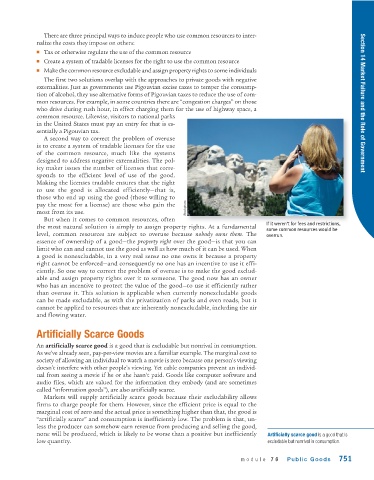Page 793 - Krugmans Economics for AP Text Book_Neat
P. 793
There are three principal ways to induce people who use common resources to inter-
nalize the costs they impose on others:
■ Tax or otherwise regulate the use of the common resource
■ Create a system of tradable licenses for the right to use the common resource
■ Make the common resource excludable and assign property rights to some individuals
The first two solutions overlap with the approaches to private goods with negative
externalities. Just as governments use Pigouvian excise taxes to temper the consump-
tion of alcohol, they use alternative forms of Pigouvian taxes to reduce the use of com-
mon resources. For example, in some countries there are “congestion charges” on those Section 14 Market Failure and the Role of Government
who drive during rush hour, in effect charging them for the use of highway space, a
common resource. Likewise, visitors to national parks
in the United States must pay an entry fee that is es-
sentially a Pigouvian tax.
A second way to correct the problem of overuse
is to create a system of tradable licenses for the use
of the common resource, much like the systems
designed to address negative externalities. The pol-
icy maker issues the number of licenses that corre-
sponds to the efficient level of use of the good.
Making the licenses tradable ensures that the right
to use the good is allocated efficiently—that is,
those who end up using the good (those willing to
pay the most for a license) are those who gain the iStockphoto
most from its use.
But when it comes to common resources, often
If it weren’t for fees and restrictions,
the most natural solution is simply to assign property rights. At a fundamental
some common resources would be
level, common resources are subject to overuse because nobody owns them. The overrun.
essence of ownership of a good—the property right over the good—is that you can
limit who can and cannot use the good as well as how much of it can be used. When
a good is nonexcludable, in a very real sense no one owns it because a property
right cannot be enforced—and consequently no one has an incentive to use it effi-
ciently. So one way to correct the problem of overuse is to make the good exclud-
able and assign property rights over it to someone. The good now has an owner
who has an incentive to protect the value of the good—to use it efficiently rather
than overuse it. This solution is applicable when currently nonexcludable goods
can be made excludable, as with the privatization of parks and even roads, but it
cannot be applied to resources that are inherently nonexcludable, including the air
and flowing water.
Artificially Scarce Goods
An artificially scarce good is a good that is excludable but nonrival in consumption.
As we’ve already seen, pay-per-view movies are a familiar example. The marginal cost to
society of allowing an individual to watch a movie is zero because one person’s viewing
doesn’t interfere with other people’s viewing. Yet cable companies prevent an individ-
ual from seeing a movie if he or she hasn’t paid. Goods like computer software and
audio files, which are valued for the information they embody (and are sometimes
called “information goods”), are also artificially scarce.
Markets will supply artificially scarce goods because their excludability allows
firms to charge people for them. However, since the efficient price is equal to the
marginal cost of zero and the actual price is something higher than that, the good is
“artificially scarce” and consumption is inefficiently low. The problem is that, un-
less the producer can somehow earn revenue from producing and selling the good,
none will be produced, which is likely to be worse than a positive but inefficiently Artificially scarce good is a good that is
low quantity. excludable but nonrival in consumption.
module 76 Public Goods 751

